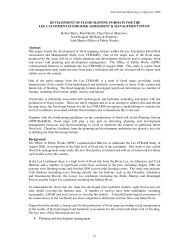Vegetation (Floating River Vegetation) - Office of Public Works
Vegetation (Floating River Vegetation) - Office of Public Works
Vegetation (Floating River Vegetation) - Office of Public Works
Create successful ePaper yourself
Turn your PDF publications into a flip-book with our unique Google optimized e-Paper software.
iver diversity. Under REPS 3, measure 5 option 3b new hedgerow replanting is encouraged. To<br />
prevent excessive shading <strong>of</strong> watercourses and provision <strong>of</strong> access for maintenance machinery,<br />
unplanted sections should be left in the proposed hedgerow rather than planting a continuous<br />
hedgerow. Hedgerow management should include coppicing to provide variation in hedgerow<br />
density shape and height. Management <strong>of</strong> trees during watercourse maintenance would be<br />
beneficial to floating river vegetation.<br />
5.2 Influence <strong>of</strong> current Environmental Drainage Maintenance work practices<br />
The current drainage maintenance under the guidance <strong>of</strong> the Environmental Drainage<br />
Maintenance Programme is and will be beneficial for floating river vegetation. For the most part the<br />
10 step recommendations for fish species are also applicable to floating river vegetation. To benefit<br />
floating river vegetation the following adjustments to the current Environmental Drainage<br />
Maintenance Programme should be considered.<br />
•Removal <strong>of</strong> vegetation should not be restricted to instream vegetation. Marginal vegetation may<br />
need to be removed especially if there is encroachment by terrestrial plant species from the river<br />
bank. Plant species such as watercress and fools watercress may also require controlling.<br />
•Phragmites, Bulrush, Bur-reed, Water celery and large marginal grasses need to be contained or<br />
removed during maintenance. Excessive growth <strong>of</strong> these plants will lead to a greater rate <strong>of</strong><br />
siltation, reducing the aquatic environment for floating river vegetation.<br />
•Riparian woodland on wide rivers was not found to interfere with the colonisation and growth<br />
<strong>of</strong> floating river vegetation. Dense sections <strong>of</strong> Willow and overgrown hedgerows on channels <strong>of</strong><br />
less than three metres wide did reduce the level <strong>of</strong> sunlight reaching the watercourse floor.<br />
Without sunlight plants cannot produce food through photosynthesis to sustain growth.<br />
Appropriate tree management should allow sunlight penetrate the riverbed.<br />
•Development <strong>of</strong> two stage channels could be beneficial to floating river vegetation. A fast<br />
flowing slightly deeper section <strong>of</strong> gravel base would favour water crowfoot species. Deep<br />
sections <strong>of</strong> river would facilitate some species <strong>of</strong> pondweed. Shallow areas <strong>of</strong> slow flow prone<br />
to sedimentation would be ideal for the water parsnip.<br />
•Placement <strong>of</strong> boulders in channels following maintenance will also be beneficial for the<br />
propagation and colonisation <strong>of</strong> floating river vegetation especially if there is evidence <strong>of</strong><br />
floating river vegetation species upstream.<br />
•There would be an element <strong>of</strong> concern regarding the loosening <strong>of</strong> channel bed gravel between<br />
mid June to mid August. Seeds associated with floating river vegetation would be present on the<br />
channel bed and or may be in the process <strong>of</strong> germination for the following year. Loosening<br />
gravel may cause the seed to be buried beneath a gravel layer or be washed away. Should the<br />
44

















